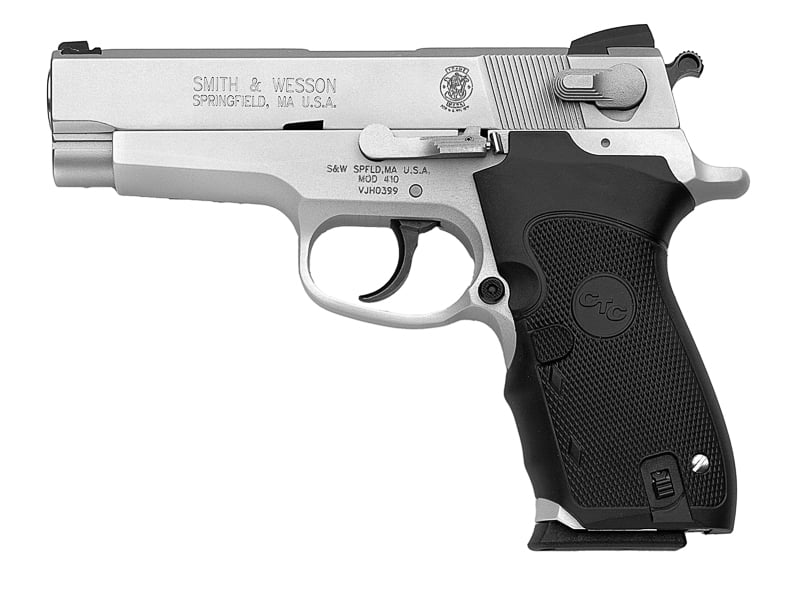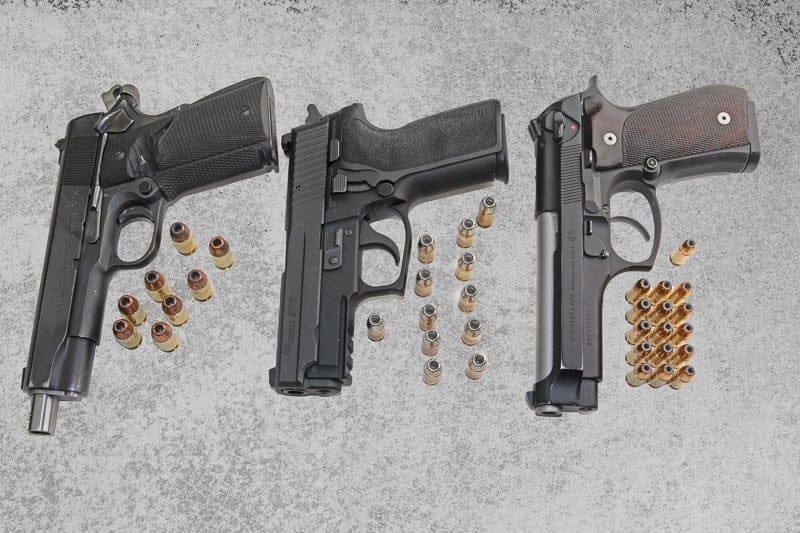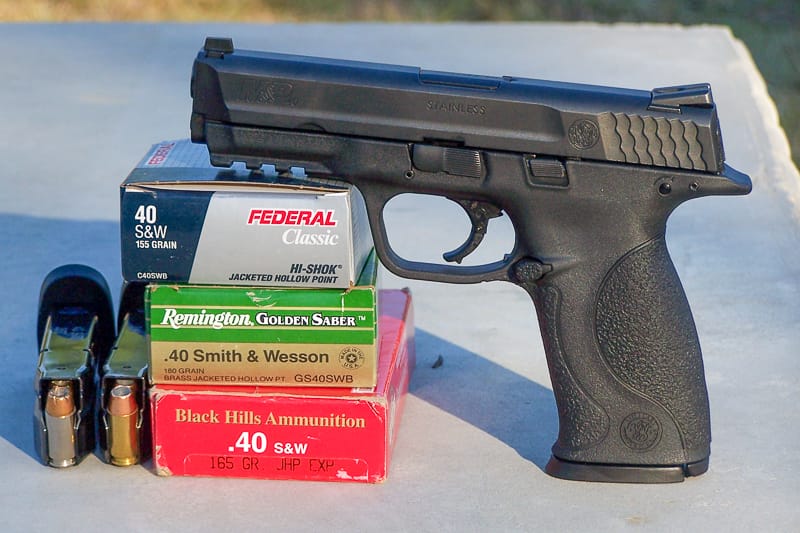The .40 Smith & Wesson cartridge was introduced in 1990. The switch from service revolvers to duty autos was progressing apace, but there were arguments among the cops as to which auto. One faction wanted firepower: 16-shot 9mms. The other faction wanted “stopping power” and preferred .45 ACP, typically in 8-round format. In the late 1980s, facing that conundrum at the FBI, Firearms Training Unit head John Hall cut that Gordian knot with the 10mm Auto, loaded down to a 180-grain bullet at around 1,000 feet per second. (Contrary to the internet myth, they didn’t choose that load because agents couldn’t handle full-power 10mm: Hall conceived it from the beginning because he felt it had the best attributes for agents.)
Master pistolsmith Paul Lieberman had joined S&W by then, working hand in hand with IPSC champion Tom Campbell and with input from other luminaries. Paul’s wildcat Centennial cartridge had basically allowed shorter than 10mm Auto overall length for a double-stack magazine and its .40 caliber bullets “made major” for IPSC shooting. As far as terminal ballistics, it pretty much duplicated the FBI 10mm load in a shorter package. The .40 S&W was born, in the solid S&W 4006 pistol, which was almost immediately adopted by the trend-setting California Highway Patrol.

It seemed the perfect compromise. The 12-round capacity of the 4006 was exactly halfway between eight .45s and sixteen 9mms, as would be true of the subsequent Beretta 96 and SIG P229 in that caliber. The firepower advocates had double the capacity of their old revolvers, and the big-bore advocates had “a caliber that begins with 4.”

When Glock quickly jumped on the bandwagon with their G22 holding 15+1 rounds of .40, a format that would be followed by S&W in their M&P pistols, it looked like the best of all worlds.

The .40 S&W gained popularity among police faster than any new caliber before it, and by the late 1990s, it had become the nation’s dominant police service pistol cartridge. Even the FBI went to it, in the G22 and the fourteen-shot Glock 23.
The .40 in the Field
The .40 S&W is a remarkably versatile cartridge, which has proved itself across the board in its many loadings. Not counting frangible or exotic bullets, the span of 135-grain through 200-grain found advocates at each tier. You see just a few examples in the lead photo for this article.
Winchester worked with S&W on the initial debut of the .40, which took the form of a 180-grain jacketed hollow point bullet at subsonic velocity – essentially, the ballistics of a .38-40 revolver in the old West. It had decent stopping power, being after all close to the 185-grain bullet at similar speeds that was, early on, which was then the most popular police duty load in .45 ACP. This first-generation loading would remain the most popular among police, with CHP proclaiming it more effective than the .357 Magnum.
Soon, we had a second generation, the 165-grain .40 JHP at 1140 feet per second and a 155-grain at 1200 fps. This was similar to the 158-grain .357 Magnum loads of the period, and not surprisingly, departments such as Nashville Metro PD issuing 165-grain Winchester Ranger and Speer Gold Dot reported takedowns as fast as with .357s.
The US Border Patrol issued Remington 155-grain and likewise reported excellent fight-stopping effects. I did more than one police shooting case involving Winchester’s 155-grain Silvertip: the bad guys had dropped with alacrity, and the bullets had expanded into starfish shape. These loads were quite accurate, as well. The third generation evolved from Richard Kelton’s experimentation with a 135-grain JHP at 1300 fps. In slaughterhouse testing, I found it equaled or exceeded 125-grain .357 Magnum in wound volume and convinced Cor-Bon to produce it.
In one shooting near Baton Rouge, the cop under attack had to shoot from the hip. The 135-grain Cor-Bon bullet caught the assailant near the navel; the officer said it was as if the attacker had bounced off an invisible wall and fallen to the ground, motionless. Cops gave him first aid rapidly, but his pupils were already fixed and dilated. At the autopsy, the forensic pathologist called Cor-Bon to ask what explosive they had put in the bullets.
Later, IPSC shooters worked up effective 200-grain handloads that made major power factors with soft recoil, and boutique ammo makers like Buffalo Bore offered deep-penetrating hard-cast 200-grain bullets for bear defense. On the other end of the scale, the FBI ordered what some of us called “minus-P” .40 loads, 165-grain JHPs slowed down to subsonic velocities. They were not impressive in the field but had the mild recoil of a 9mm +P.

The Descent of the .40
From early on it was apparent that .40 S&W was a high-pressure cartridge with high slide velocity, increasing wear on the guns. 9mm pistols simply rechambered to .40 didn’t hold up all that well to constant shooting. Guns built from the ground up for the caliber did better: the SIGs, the HKs, and the Smith & Wesson Military & Police. The latter series including the little Shield seemed to be the softest “kicking” .40s. Across the board, .40’s recoil springs had to be replaced much more frequently than with similar size 9mms.

The .40 had a very snappy recoil, sharper even than a .45s. Even the FBI reluctantly authorized the issue of 9mm Glocks for agents who could not qualify with the standard issue .40s.
In about 2010, the .40 was the most popular police sidearm in the USA. In the next decade, however, the influential FBI released their study which determined that all the “service calibers” were pretty much the same in “stopping power” and one could load a couple of extra 9mm rounds in the same size pistol as a .40. The Bureau itself transitioned to the Glock 19M in 9mm, and a wave of “we’re going back to 9mm” became a tsunami in law enforcement.
The Situation Today
The .40’s fall from popularity was precipitous. Today, there are gun shops where if you want a .40 you’ll have to order one because they don’t keep them in stock, and they won’t even take one in trade because no one seems to want to buy a used one.
The good news is, the market is currently glutted with traded-in police .40s, some still new, which sell for ridiculously low prices, as little as the $300 range. The .40 S&W remains a proven cartridge and, as noted above, an extremely versatile one. If the user can handle a bit of recoil, the .40 S&W pistol bought second-hand represents a “best buy” today.


